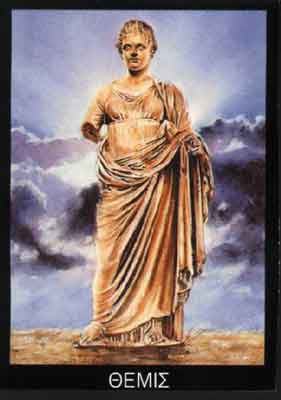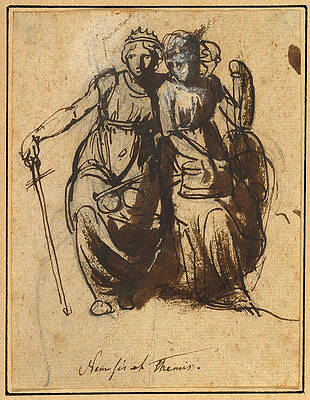
Themis of Chairestratos, 320-316 BC, found in the temple of Nemesis in Rhamnous , H: 2.22 m, National Museum (Ethniko Mouseio) Athens, Greece
In Greek mythology, Hesiod mentions Themis among the six sons and six daughters—of whom Cronos was one—of Gaia and Ouranos, that is, of Earth with Sky. Among these Titans of primordial myth, few were venerated at specific sanctuaries in classical times, and Themis was so ancient that the followers of Zeus claimed that it was with him she produced the Three Fates themselves (Hesiod, Theogony, 904). A fragment of Pindar,however, tells that the Moirae were already present at the nuptials of Zeus and Themis, that in fact the Moirae rose with Themis from the springs of Okeanos the encircling World-Ocean and accompanied her up the bright sun-path to meet Zeus at Olympus. With Zeus she more certainly bore the Horae, those embodiments of the right moment— the rightness of Order unfolding in Time— and Astraea. Themis was there at Delos to witness the birth of Apollo.
Themis (meaning "law of nature" rather than "human ordinance"), she "of good counsel," was the embodiment of divine order, law and custom. When Themis is disregarded, Nemesis brings just and wrathful retribution. Themis is not wrathful: she, "of the lovely cheeks" was the first to offer Hera a cup when she returned to Olympus distraught over threats from Zeus (Iliad xv.88). Themis presided over the proper relation between man and woman, the basis of the rightly ordered family, and the family the pillar of the deme, and judges were often referred to as "themistopoloi" (the servants of Themis). Such was the basis for order upon Olympus too. Hera addressed her as "Lady Themis."
The name of Themis might be substituted for Adrasteia in the birth of Zeus on Crete. She built the Oracle at Delphi and was herself oracular. Themis was one of the gods behind the Oracle at Delphi, which she received from Gaia and gave to Phoebe.
Consorts/Children
With Zeus
Horae: the Hours
First Generation (other names are also known)
Auxo (the Grower)
Carpo (the Fruit-bringer)
Thallo (the Plant-raiser)
Second Generation
Dike (Trial), known as Astraea in Roman mythology, the constellation Virgo
Eirene (Peace)
Eunomia (Rule of Law)
Moirae: the Fates
Atropos (the Inevitable)
Clotho (the Weaver)
Lachesis (the Lot-caster
A Roman equivalent of one aspect of Hellenic Themis, as the personification of the divine rightness of law, was Iustitia (Anglicized as Justitia). Her origins are in civic abstractions of a Roman mindset, rather than archaic mythology, so drawing comparisons is not fruitful. Portrayed as an impassive woman, blindfolded and holding scales and a cornucopia, the sculpted figure outside a county courthouse is Iustitia, not Themis (illustration, above right).

The supreme court of Greece, called "Themidos Melathron" (Θέμιδος Μέλαθρον), i.e. house of Themis
There is also an asteroid 24 Themis.
John A. Sanford, Fate, Love, and Ecstasy: Wisdom from the Lesser-Known Goddesses of the Greeks ,Chiron Publications 1995
Themis was the name given by William Henry Pickering in 1905 to a spurious tenth satellite of Saturn which he claimed to have discovered.
Nemesis and Themis, Nicolai Abildgaard
See also : Greek Mythology. Paintings, Drawings
Greek Mythology Index
A - B - C - D - E - F - G - H - I - J - K - L - M -
N - O - P - Q - R - S - T - U - V - W - X - Y - Z
Α - Β - Γ - Δ - Ε - Ζ - Η - Θ - Ι - Κ - Λ - Μ -
Ν - Ξ - Ο - Π - Ρ - Σ - Τ - Υ - Φ - Χ - Ψ - Ω
Retrieved from "http://en.wikipedia.org/"
All text is available under the terms of the GNU Free Documentation License
| Ancient Greece
Science, Technology , Medicine , Warfare, , Biographies , Life , Cities/Places/Maps , Arts , Literature , Philosophy ,Olympics, Mythology , History , Images Medieval Greece / Byzantine Empire Science, Technology, Arts, , Warfare , Literature, Biographies, Icons, History Modern Greece Cities, Islands, Regions, Fauna/Flora ,Biographies , History , Warfare, Science/Technology, Literature, Music , Arts , Film/Actors , Sport , Fashion --- |


